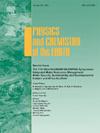阿曼Al Masaraat含水层地下水天然放射性危害评估
IF 3
3区 地球科学
Q2 GEOSCIENCES, MULTIDISCIPLINARY
引用次数: 0
摘要
通过分析放射性核素来评估饮用水的放射性健康风险对公共卫生研究至关重要,因为它提供了对人口暴露水平的见解。本研究首次对饮用水源的主要来源阿曼Al Dhahirah省的地下水水质进行了综合评价。本研究使用超纯锗探测器(HPGe)评估了天然存在的放射性核素(238U, 232Th, 40K)的污染风险。此外,确定内部和外部辐射危害指数(Hex和Hin),以确定地下水是否符合安全标准,为指导公众健康保护和环境可持续性提供重要数据。结果表明,水呈微碱性,溶解盐含量适中,电导率(EC)和总溶解固体(TDS)读数证明了这一点。所有样品中的放射性核素浓度(238U、232Th和40K)均低于世界卫生组织(世卫组织)允许的饮用水限值。计算出的两个年龄组的年有效剂量也远低于世卫组织建议的0.10毫西弗/年的阈值,表明生活在这些地区的居民不存在因地下水消耗而受到辐射照射的风险。此外,危害指数(Hex和Hin)低于参考水平,表明辐射没有重大的健康风险。总之,地下水在化学和放射学上适合于家庭和灌溉用途。根据调查结果,研究地区的地下水可用于饮用和农业目的,对当地人口的辐射健康风险实际上微不足道。相反,定期监测放射性核素浓度和水质参数指标对于确保水安全的可持续性至关重要,特别是在即将发生可能影响地下水组成的地质或人为变化的情况下。本文章由计算机程序翻译,如有差异,请以英文原文为准。
Assessment of radiological hazards due to natural radioactivity in groundwater from Al Masaraat aquifer, Oman
Evaluating radiological health risks of drinking water by analyzing radionuclides is essential for public health studies, as it provides insights into population exposure levels. This research presents the first comprehensive evaluation of the quality of groundwater in Al Dhahirah Governorate, Oman, which is the major source of drinking water source. This investigation evaluates the risks of contamination from naturally occurring radionuclides (238U, 232Th, 40K) using a Hyper Pure Germanium detector (HPGe). Additionally, determine both internal and external radiation hazard indices (Hex and Hin) to determine whether the groundwater meets safety standards, providing essential data to guide public health protection and environmental sustainability. The findings indicated that the water is slightly alkaline, with moderate levels of dissolved salts, as evidenced by electrical conductivity (EC) and total dissolved solids (TDS) readings. Radionuclide concentrations (238U, 232Th, and 40K) in all samples were below the World Health Organization (WHO) permissible limits for drinking water. The calculated annual effective doses (AEDs) for two age groups were also well below the WHO-recommended threshold of 0.10 mSv/year, indicating that the residents living in these areas are not at risk from radiological exposure due to groundwater consumption. Furthermore, hazard indices (Hex and Hin) were below reference levels, indicating no significant health risks from radiation. In conclusion, groundwater is chemically and radiologically suitable for domestic and irrigation purposes. Based on the findings, the groundwater from the study area can be used for drinking and agricultural purposes with practically insignificant radiological health risks towards the local population. Conversely, routine monitoring of radionuclide concentrations and indicators of water quality parameters is crucial to ensure sustainability of the water safety, especially where there may be impending geological or anthropogenic changes that might influence groundwater composition.
求助全文
通过发布文献求助,成功后即可免费获取论文全文。
去求助
来源期刊

Physics and Chemistry of the Earth
地学-地球科学综合
CiteScore
5.40
自引率
2.70%
发文量
176
审稿时长
31.6 weeks
期刊介绍:
Physics and Chemistry of the Earth is an international interdisciplinary journal for the rapid publication of collections of refereed communications in separate thematic issues, either stemming from scientific meetings, or, especially compiled for the occasion. There is no restriction on the length of articles published in the journal. Physics and Chemistry of the Earth incorporates the separate Parts A, B and C which existed until the end of 2001.
Please note: the Editors are unable to consider submissions that are not invited or linked to a thematic issue. Please do not submit unsolicited papers.
The journal covers the following subject areas:
-Solid Earth and Geodesy:
(geology, geochemistry, tectonophysics, seismology, volcanology, palaeomagnetism and rock magnetism, electromagnetism and potential fields, marine and environmental geosciences as well as geodesy).
-Hydrology, Oceans and Atmosphere:
(hydrology and water resources research, engineering and management, oceanography and oceanic chemistry, shelf, sea, lake and river sciences, meteorology and atmospheric sciences incl. chemistry as well as climatology and glaciology).
-Solar-Terrestrial and Planetary Science:
(solar, heliospheric and solar-planetary sciences, geology, geophysics and atmospheric sciences of planets, satellites and small bodies as well as cosmochemistry and exobiology).
 求助内容:
求助内容: 应助结果提醒方式:
应助结果提醒方式:


